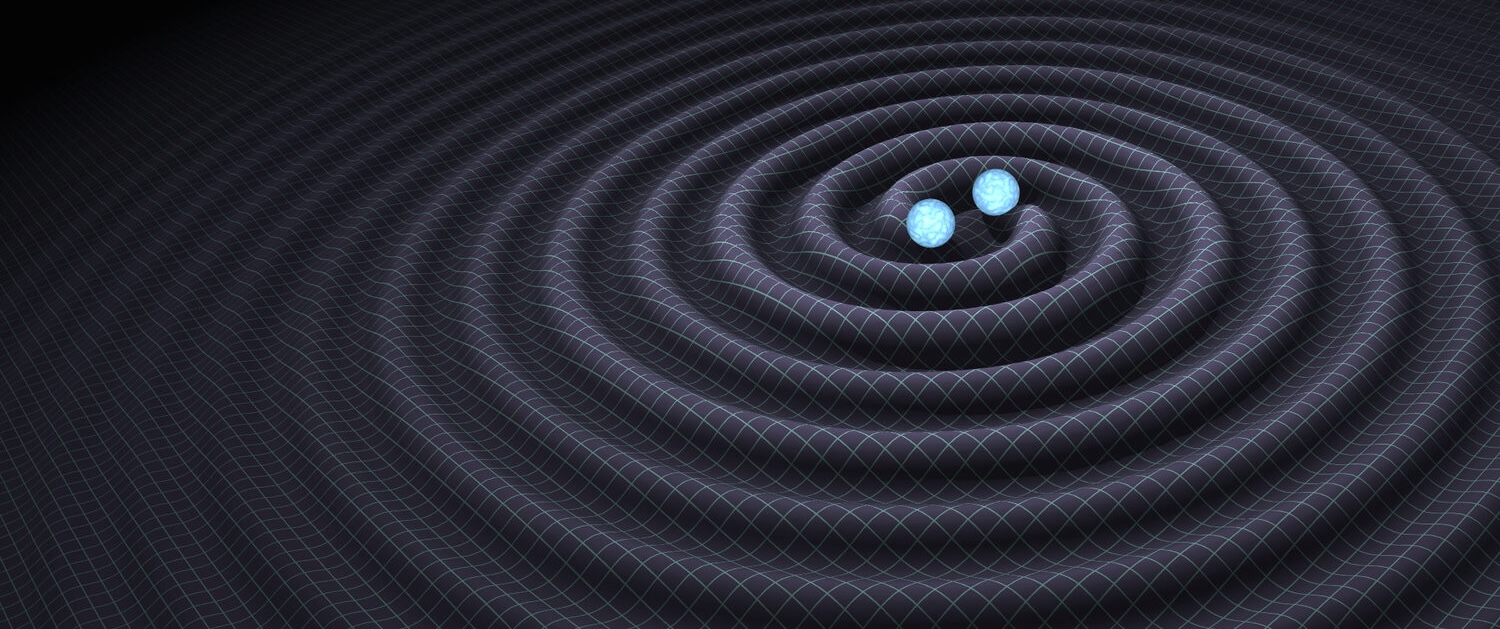During the final months of 2024, the LIGO-Virgo-KAGRA (LVK) collaboration detected GW241011 and GW241110: two remarkably similar gravitational-wave events (and not just in their names). The first of the pair, GW241011, was detected on October 11, 2024, at 23:38:34 UTC. GW241110 was detected almost exactly a month later, on November 10 at 12:41:23 UTC. Both of these events are black hole binaries that are rapidly spinning and in each case their black holes have unequal masses. These properties have implications for our understanding of black hole pair formation and evolution, as well as various areas of fundamental physics.
Catching the signals
The LIGO and Virgo detectors identified both events during the second part of LIGO-Virgo-KAGRA’s fourth observing run (O4b). Figure 1 shows the amplitude of the data recorded over time for these events.
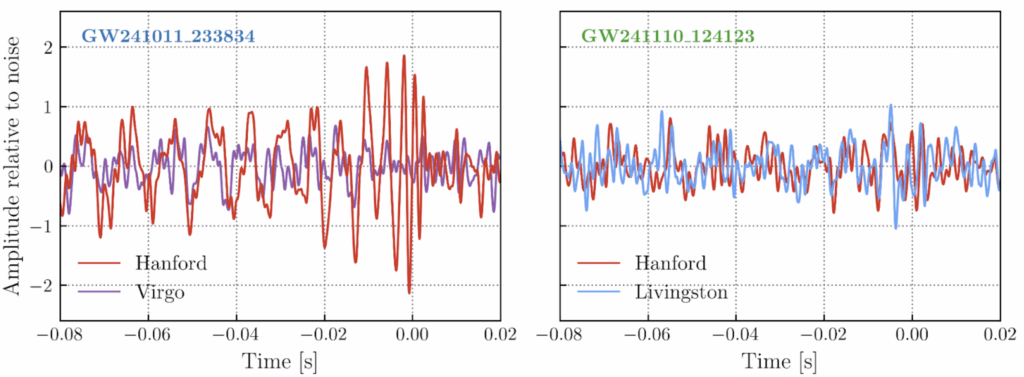
Figure 1: The panels show the amplitude of the data over time in a combination of the LIGO Hanford, LIGO Livingston and Virgo detectors for GW241011 (left) and GW241110 (right). The merger time of the events is at Time = 0.
GW241011 stood out immediately, rising well above the typical noise in both detectors. In LIGO Hanford, the signal was about 35 times stronger than the background noise, while Virgo detected it at roughly 9 times the noise level. LIGO Livingston was not operating at the time. Using advanced search algorithms and statistical techniques, we found that the probability of random noise mimicking this signal is less than once in 1026 years, far longer than the age of the universe.
GW241110 was detected a month later, and this time all three detectors were observing. Although the signal was quieter than GW241011, it was clearly visible in both LIGO instruments, with Virgo contributing a weaker signal. Ground motion at the Livingston detector was at a high level, resulting in some low-frequency noise; however, this did not significantly impact the detection. After careful analysis, we estimated that the chance of this signal being caused by random noise is less than once every 1500 years.
What created these signals?
Each event was the result of a violent merger of two black holes. GW241011 was a gravitational-wave signal from the collision of two black holes weighing in at roughly 20 and 6 times the mass of our Sun, whereas the black holes in GW241110 were about 17 and 8 times the Sun’s mass — strikingly similar! (See Figure 2, lower panel.) Both were also rapidly spinning, with the spin of GW241011 being precisely measured. (See Figure 2, upper panel.)
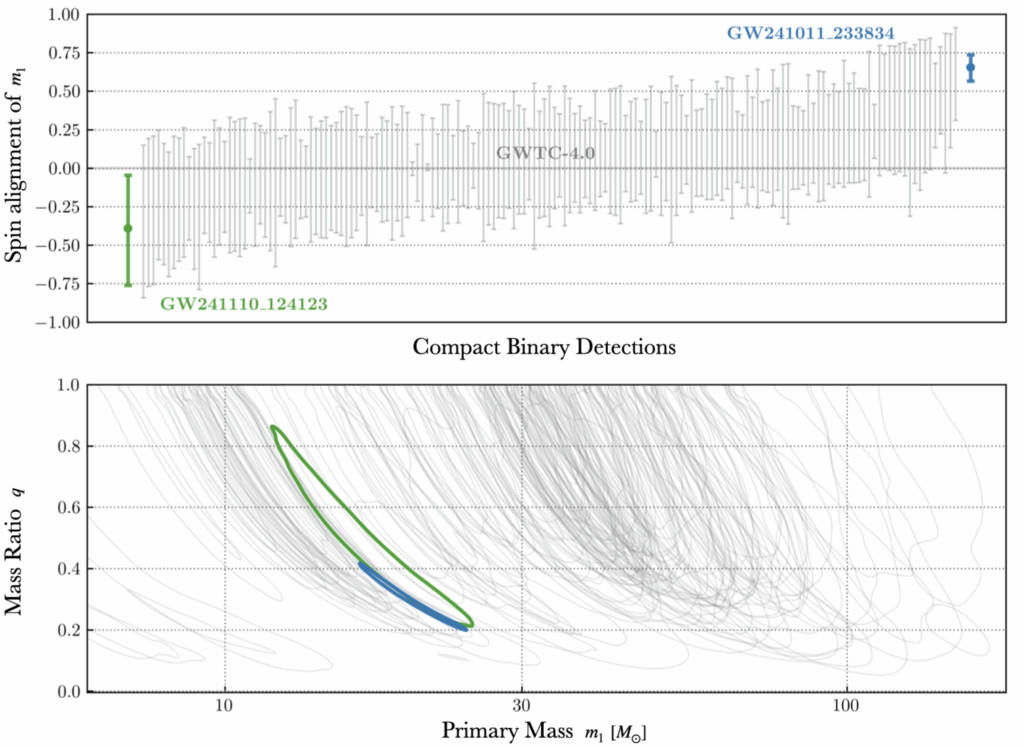
Figure 2: (Adapted from Figure 1 of our publication) The top panel shows all the events from the LVK’s most recently published catalog, GWTC-4, and our two new events GW241011 and GW241110 ordered by the primary spin projected in the direction of the spin of the orbital plane — in other words, how aligned the primary black hole’s spin direction is with the binary system’s orbit direction. Values greater than zero means the black hole is aligned with the spin of the orbit, whereas less than zero means the system is anti-aligned. The bottom panel shows the distribution of primary mass (the mass of the larger black hole) in solar masses and the mass ratio of the black hole pair for all events from GWTC-4 including our new events.
Spinning an evolutionary tale
These two events share some interesting features: in each pair, the more massive black hole (referred to as the primary black hole) had a well-measured spin. The spin orientations of the two primary black holes were also not perfectly aligned with their orbits, and each pair had one black hole that was about twice as massive as the other. These clues suggest that the primary black hole in each pair might have come from an earlier black hole merger — making it what we call a “second-generation” black hole (see Figure 3). This scenario is called a hierarchical merger and it points to the possibility that these systems formed in dense environments, in regions like star clusters, where black holes are more likely to run into each other and merge again and again. However, we cannot rule out the alternative scenario that both of these systems resulted from a pair of stars evolving in isolation.
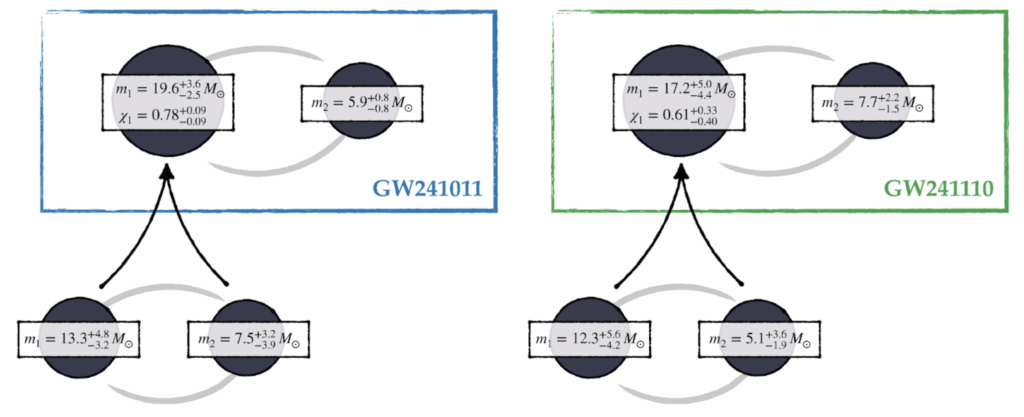
Figure 3: (Adapted from Figure 7 of our publication.) The black hole pair in each of the events GW241011 and GW241110 is shown, together with the possible ancestors of the primary black hole of each pair. The estimated mass, in units of the Sun’s mass, and its uncertainty is indicated for each black hole. The measured spin, χ, of the primary black hole of each pair is also shown.
Implications for fundamental physics
The remarkably precise and confident spin measurement of GW241011’s primary black hole allowed us to test a key prediction of Einstein’s theory of general relativity, known as the black hole’s spin-induced quadrupole moment. This effect describes how rapid rotation slightly distorts a black hole’s shape and alters the gravitational waves it emits. By carefully analyzing GW241011’s signal (see Figure 4), we verified Einstein’s prediction about this effect with unprecedented accuracy (yes, he was right again!), placing the strongest constraints to date on this aspect of spinning black holes.
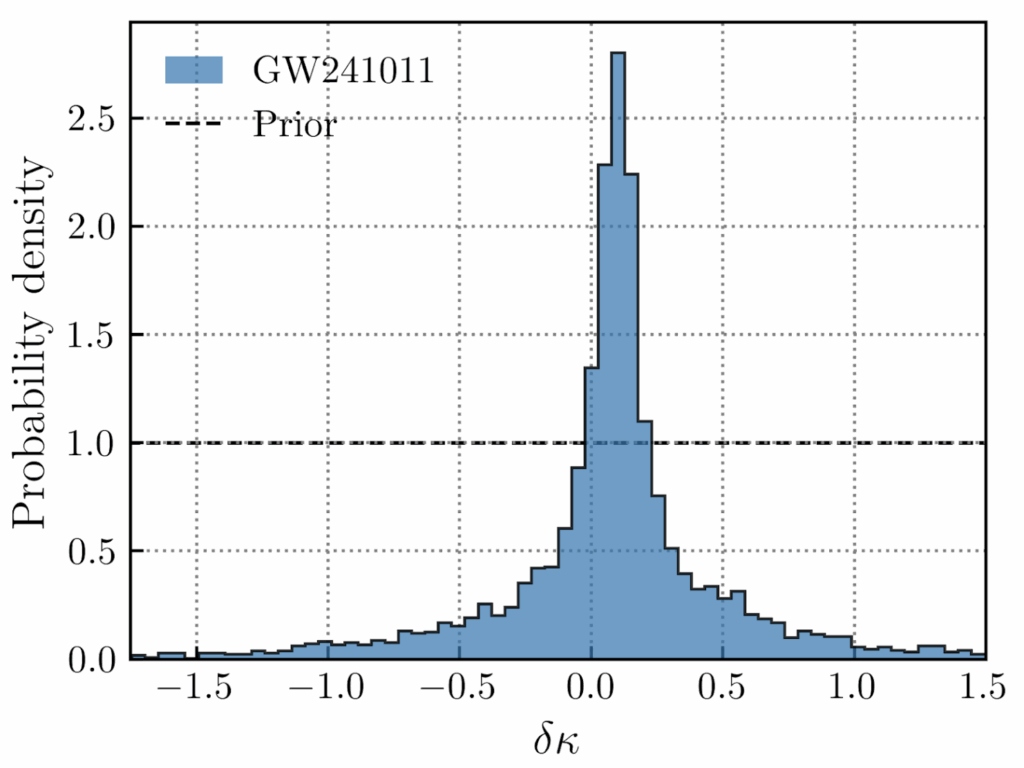
Figure 4: (Adapted from Figure 9 of our publication) The deviation from the prediction of General Relativity for the spin-induced quadrupole moment of GW241011’s primary black hole. The deviation is consistent with zero, indicating that the event is consistent with Einstein’s theory.
Spinning black holes, such as the primary black holes of GW241011 and GW241110, also allow us to test for the existence of new, undiscovered particles. Some theories predict that ultralight bosons (which are candidate “dark matter” particles far lighter than anything in the Standard Model of particle physics) could gradually “extract” spin from black holes over time. If such particles exist within a certain mass range and were found in clouds around the primary black holes of GW241011 and GW241110, they would have caused the spin rate of the black holes to slow down long before they merged. With both the primary black holes observed to be still spinning rapidly, this rules out a wide range of possible masses for these boson particles, making these events powerful probes of new physics.
Conclusion
The detection of GW241011 and GW241110 highlights the remarkable progress of gravitational-wave astronomy in uncovering the hidden lives of merging black holes. Both systems point toward the possibility of “second-generation” black holes formed in dense environments where mergers can occur repeatedly. Moreover, GW241011’s unprecedented measurement of spins and higher-order multipoles allowed general relativity to be put to the test under extreme conditions, with our results showing no deviations from Einstein’s predictions. The insights we gain with every detection help us piece together the grand puzzle of the universe, reminding us that each event is not only an astrophysical discovery but also a laboratory for probing the fundamental laws of physics.
Find out more:
- Visit our websites:
- Read the full scientific article here.
- Gravitational-Wave Open Science Centre data release:
- Data for GW241011: https://doi.org/10.7935/3drz-8m81
- Data for GW241110: https://doi.org/10.7935/46xh-t016
Back to the overview of science summaries.

